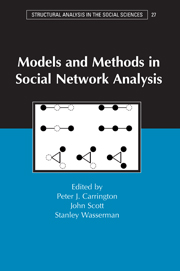Book contents
- Frontmatter
- Contents
- Acknowledgments
- Contributors
- 1 Introduction
- 2 Recent Developments in Network Measurement
- 3 Network Sampling and Model Fitting
- 4 Extending Centrality
- 5 Positional Analyses of Sociometric Data
- 6 Network Models and Methods for Studying the Diffusion of Innovations
- 7 Using Correspondence Analysis for Joint Displays of Affiliation Networks
- 8 An Introduction to Random Graphs, Dependence Graphs, and p*
- 9 Random Graph Models for Social Networks: Multiple Relations or Multiple Raters
- 10 Interdependencies and Social Processes: Dependence Graphs and Generalized Dependence Structures
- 11 Models for Longitudinal Network Data
- 12 Graphic Techniques for Exploring Social Network Data
- 13 Software for Social Network Analysis
- Index
- Structural Analysis in the Social Sciences
7 - Using Correspondence Analysis for Joint Displays of Affiliation Networks
Published online by Cambridge University Press: 05 June 2012
- Frontmatter
- Contents
- Acknowledgments
- Contributors
- 1 Introduction
- 2 Recent Developments in Network Measurement
- 3 Network Sampling and Model Fitting
- 4 Extending Centrality
- 5 Positional Analyses of Sociometric Data
- 6 Network Models and Methods for Studying the Diffusion of Innovations
- 7 Using Correspondence Analysis for Joint Displays of Affiliation Networks
- 8 An Introduction to Random Graphs, Dependence Graphs, and p*
- 9 Random Graph Models for Social Networks: Multiple Relations or Multiple Raters
- 10 Interdependencies and Social Processes: Dependence Graphs and Generalized Dependence Structures
- 11 Models for Longitudinal Network Data
- 12 Graphic Techniques for Exploring Social Network Data
- 13 Software for Social Network Analysis
- Index
- Structural Analysis in the Social Sciences
Summary
This chapter describes and illustrates methods for studying affiliation networks, with special attention to methods for spatial representations that jointly display the actors and events in the network. Although affiliation networks have been the focus of methodological research for decades (Levine 1972; Breiger 1974; Seidman 1981; McPherson 1982; Wilson 1982), more recent analyses of affiliation networks have raised a number of issues concerning appropriate methods for their study. At the same time, research has pointed to the empirical and theoretical generality of this perspective (Freeman and White 1993; Wasserman and Faust 1994; Borgatti and Everett 1997; Faust 1997; Skvoretz and Faust 1999; Breiger 2000; Mische and Pattison 2000; Roberts 2000; Brazill and Groffman 2002; Faust et al. 2002; Pattison and Breiger 2002).
Background
Representing the two modes in the affiliation network in a “joint space” in which both actors and events are depicted simultaneously is of particular interest in both earlier and more recent work on affiliation networks. Such graphic displays commonly use scaling (e.g., correspondence analysis) or algebraic approaches (e.g., lattices). An important, but often neglected, aspect of some applications is clear specification of the formal relationships embodied in the configuration and explicit description of how the result corresponds to the original data. These omissions produce rather casual depictions and consequent ambiguity in interpretation. They also contribute to misunderstanding and fuel debate about the usefulness of the approach. The following passages are typical of such descriptions for affiliation networks or similar two-mode data arrays.
- Type
- Chapter
- Information
- Models and Methods in Social Network Analysis , pp. 117 - 147Publisher: Cambridge University PressPrint publication year: 2005
- 25
- Cited by



